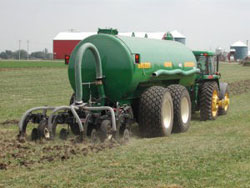



Warning over Pathogens, Antibiotic-resistant Organisms in Manure
CANADA - An enormous responsibility for all hog producers is to manage the health of the herd. There is no question that a healthy herd has the best opportunity to be a productive herd, writes Glenn Kuhn, Swine Technical Manager at Genesus Inc.In order to achieve these goals, producers face a variety of decisions and challenges along the way which lead to some of the following questions: What is the best genetics package for my operation? How do I maintain the health of my herd using biosecurity? What disease challenges does my herd face and what medication and vaccination program do I follow? What will my herd’s nutritional program be? What is the value of my manure as a fertilizer?
A question unlikely to be at the forefront of producer’s minds when it comes to applying manure is, "Are there dangerous pathogens or antibiotic resistant organisms in my manure and what impact on the soil or water sources can it have?" For the most part, producers are primarily concerned with optimizing production, managing disease through responsible use of antibiotics and applying manure to cropland in the safest, least expensive and most efficient way possible. However, as the general public continues to scrutinize intensive livestock production, the aforementioned question is likely to be asked more often.
 Researchers at the University of Manitoba Glenlea Research Station have completed a multi-year study of the effects of hog manure application on pasture land as it pertains specifically to whether the possibility exists for pathogens and antibiotic resistant organisms to be transferred from hog manure application to either surface or ground water or into the soil.
Researchers at the University of Manitoba Glenlea Research Station have completed a multi-year study of the effects of hog manure application on pasture land as it pertains specifically to whether the possibility exists for pathogens and antibiotic resistant organisms to be transferred from hog manure application to either surface or ground water or into the soil.
The main focus of the studies was to observe the presence or persistence of both E. coli and Salmonella as well as microbes subjected to a variety of common antibiotic treatments. Hog manure was analysed prior to application, soil and vegetation was analysed before and after application, ground water was analyzed at four different points in time during the year and cattle which grazed the test plots had their feces analyzed for pathogens and microbes identified in the hog manure. As well, cattle feces from non-hog manure applied pasture land were also analysed.
According to their findings (which were repeated at many different time intervals over the course of two years) Salmonella and E. coli did not appear to be transferred from hog manure to cattle grazing on manure-treated fields (Holley, Krause, Walkty, Little, Cheng and Dengpan). Antibiotic resistant microbes may get into the groundwater from hog manure, but this contamination is not extensive and that the possibility exists that over time and with soil filtration the low incidence organisms may disappear at together (Holley, Krause, et al).
Interestingly, pasture land that had no hog manure application, actually contained, "the highest number of antibiotic resistant microbes in groundwater samples" (Holley, Krause, et al).
While hog producers can take some comfort in these findings knowing that continuing to use antibiotics to control certain pathogens in the responsible manner which they have been, it begs the question, "Will hog producers one day be required to treat their manure before applying it?". While it seems unlikely, the more producers know about what is present in their manure and what takes place after application, the better prepared they are to push back when someone not involved in animal production asks them if applying manure to the land is safe or not.









